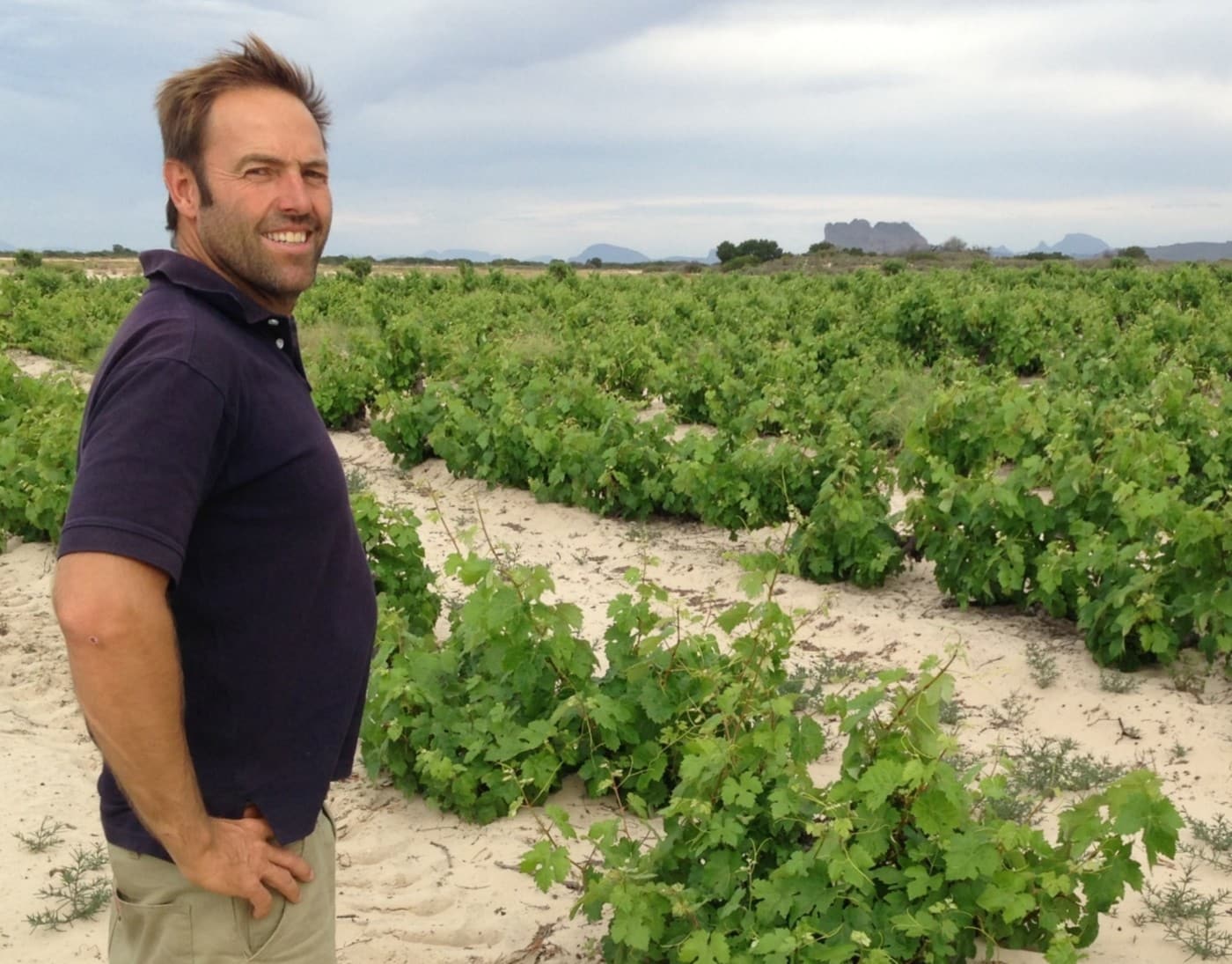Tim James: The forthcoming Sadie new releases
By Tim James, 5 July 2019

Eben Sadie in Skerpioen vineyard.
As I described last week, the forthcoming Sadie Family Wines releases were picked in the teeth of the drought (see here). Volumes of the Ou Wingerdreeks wines are generally severely down on pre-drought norms, and acidity and ripeness were also generally affected. There’s no obvious lightness on any of the wines to suggest that their development over a reasonable number of years will be seriously affected, especially as they are all well balanced. However, especially given the lower acidity it would probably be just as well – as Eben Sadie himself suggests – to drink the 2017 and these 2018 wines earlier than the more recent pre-drought vintages.
That caveat doesn’t apply to the 2017 Columella and Palladius, which both have the advantage of being selections from a wide range of varieties and Swartland locations, rather than being dependent on small, single vineyards, as is the case with the others.
In fact, my impression was that Columella 2017 is the finest vintage yet, of a wine that has changed remarkably since the maiden 2000. Eben has never said other than that this is a work in progress: to say that “building a great wine is not the work of one generation” is both modest and claimful. That first Columella (still drinking very well) had about 85% syrah, with the remainder mourvèdre. Now there are half a dozen varieties in the blend, with syrah down to 40%. New oak is down to 8% for a year (from 65%), with a second year in big old oval casks. Especially since 2010, there’s been an ever-increasing finesse and freshness, and the wine (in fact like all these wines) is getting less assertive – though with a subtle, unignorable insistence and density. So while the 2017 has an almost austere core, it’s wrapped in a sweet-fruited sensuality. It’s still very tight and deserves many years of careful maturation.
Palladius seems to me to have changed over the years perhaps even more than Columella, and its gains in freshness, lower alcohol and greater dryness perhaps culminate in the refined, fresh, delicate power, great balance and length of 2017 (picked a little earlier than previously): “Just enough of everything, not too much of anything”, I concluded at this tasting. This vintage comes from 17 vineyards and 11 varieties; fermentation and initial maturation only in concrete and clay, then it’s blended into big oak casks, for settling.
Here follow some briefer, less edited notes on the Old Vines Series.
Soldaat 2018: Piekenierskloof grenache. Picked at usual ripeness but a small crop. Only concrete maturation. Subtle dark, spiced perfume. Bright red fruit. Very decent acidity. Depth of flavour. Very precise, clean. Fresh. Young and tight, touch of rawness, but already delectable. Slightly austere purity.
Pofadder 2018: Picked even earlier than 2017. 85% whole cluster fermentation. Lovely light perfume, pretty. Very bright and light, subtle fruit. Very interesting, quite serious, but lightweight by its own standards. Some charm but less than usual; an austere, young grippiness. Powdery dry tannin. Aged in big conical oak. Cleared off lees earlier than usual, like Soldaat. Cinsaut seems to have suffered most from the drought, but this is still a good wine, though I think for drinking quite early.
Treinspoor 2018. Swartland tinta barocca. Very small yield. Richer, darker, full aromas, quite complex already. Tannins big, but really well integrated and succulent. Lovely depth of fruit. 15% destemmed, in big old oak. Most attractively savoury. (I’ve grown to enjoy this wine more each year as the tannin management has improved; but maybe I was wrong to not much care for earlier vintages; I’m told they have matured very well.)
All these wines are bone dry and elegant.
Skerpioen 2018. The lowest alcohol vineyard this year. Lightly fruity aromas. Good bite of acid, touch of phenolics, again the austerity obvious. Mineral, salty. Good fruit density, enough, and growing in the glass, which is a good sign.
Skurfberg 2018. These Clanwilliam vineyards were hardest hit – 30-40% of normal vintage. Picked early. More forward Chenin nose – dried peach, thatch. Yet some good substance, all fresh, yet lightness of texture and fruit. Nice grip. Lovely flavours though. More charming in youth than Skerpioen.
Kokerboom 2018. Mysterious nose, really gorgeous. Very poor yields. Picked very early to save the vines, giving a lightness and herbaceous edge – more like cooler climate semillon. Less obviously fruity, more gingerbread, spice. Salty. Fine acid. Eben seemed almost apologetic about this wine, but apart from its seeming likely to be less long-lasting than usual, I loved it.
’T Voetpad 2018. Field blend – chenin, palomino, semillon. Dried fruit, quiet nose. Vineyard suffered badly from poor fruitset, so minuscule production. Some intensity and a good acidity from early picking. A bit awkward in youth. Savoury, less obvious fruit – some quince, apricot. Opens in glass, but opulence, power a touch less this year.
Mev. Kirsten 2018. Chenin from urban Stellenbosch; the most regular crop this year. Greatly delicate, gently aromatic nose. Subtle apricot. Superbly intense yet refined. Dense, steely. Altogether complete. Kernel of sucrosity surrounded by steel. Grandeur.
***
The wines will be released on 29 July 2019. The winter rains have started at last, so perhaps we can hope for these amazing, survivalist vines to recover fully. No Voetpad was made in 2019. But it looks like (“Maybe!”, says Eben) there will be two new Sadie wines released this time next year.
- Tim James is one of South Africa’s leading wine commentators, contributing to various local and international wine publications. He is a taster (and associate editor) for Platter’s. His book Wines of South Africa – Tradition and Revolution appeared in 2013.








Comments
0 comment(s)
Please read our Comments Policy here.